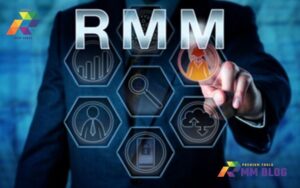RMM – In today’s fast-paced IT environment, businesses rely heavily on robust tools to manage their systems. One of the most crucial tools for maintaining smooth operations is the RMM ticketing system. This system not only helps in monitoring remote devices but also streamlines the process of addressing IT issues efficiently.
By automating alerts and support requests, an RMM ticketing system plays a pivotal role in optimizing response times, reducing downtime, and improving customer satisfaction. In this article, we’ll explore how these systems work, recommend the best ones, and provide tips on selecting the right RMM ticketing system for your needs.
Table of Contents:
How RMM Ticketing Systems Work
To understand the full value of an RMM ticketing system, it’s important to break down its core components and how they function to streamline IT management.
1. Monitoring and Detection
An RMM ticketing system continuously monitors your network and connected devices, identifying potential issues before they escalate.
This includes tracking system performance, monitoring software updates, and ensuring all endpoints are secure. By detecting problems early, the system helps prevent costly downtime and ensures that IT staff can focus on critical tasks.
2. Automated Ticket Generation
When the system detects an issue, it automatically creates a ticket with detailed information about the problem. This automation eliminates the need for manual ticket creation and reduces the risk of human error.
The system categorizes and prioritizes the ticket based on the severity of the issue, ensuring that urgent problems receive immediate attention.
3. Issue Assignment and Tracking
Once the ticket is generated, it is assigned to the relevant technician or team. The RMM ticketing system allows for easy tracking of ticket progress, ensuring that no issue goes unresolved. IT managers can monitor the status of all tickets in real time, providing transparency and accountability within the team.
Maximize Efficiency with RMM ConnectWise for Your Business

4. Resolution and Reporting
As technicians resolve tickets, they can log the actions taken within the system, creating a record of the resolution process. This data can later be used for reporting and identifying patterns in recurring issues.
The RMM ticketing system also allows businesses to generate reports that show key metrics, such as resolution times and ticket volume, helping optimize future IT operations.
By integrating these elements, an RMM ticketing system becomes an indispensable tool for efficient IT management, providing automation, clarity, and improved response times to IT issues.
How RMM Ticketing Systems Work
To fully appreciate the benefits of an RMM ticketing system, it’s essential to understand how its various components work together to streamline IT operations and enhance support efficiency.
1. Monitoring and Detection
At the heart of any RMM ticketing system is its ability to continuously monitor the health and performance of devices, servers, and networks. This system keeps a constant eye on critical aspects like CPU usage, disk space, software updates, and security threats.
By detecting any deviations from normal operations, the system identifies potential problems before they disrupt your business. For example, if a server’s performance drops or a software patch is outdated, the system flags this as an issue, prompting action to prevent larger breakdowns.
2. Automated Ticket Generation
Once the monitoring system detects an issue, the RMM ticketing system automatically generates a support ticket. The ticket contains all the essential details, such as the nature of the problem, affected device, and any additional diagnostic data.
Automation ensures that no issue goes unnoticed and significantly reduces manual input, which can lead to delays or errors. The ticket is then assigned a priority level, depending on the severity of the issue, ensuring that more critical problems are handled with urgency.
Top RMM Tools for MSPs: Enhance Efficiency & Security

3. Issue Assignment and Tracking
After the ticket is created, it is automatically assigned to the appropriate technician or IT team for resolution. The RMM ticketing system allows for seamless tracking of the ticket’s status throughout its lifecycle. Managers can view which tickets are open, in progress, or resolved, offering complete visibility into the team’s workflow.
This level of organization ensures that no ticket falls through the cracks, and technicians are able to stay on top of their tasks, all while improving the overall efficiency of the support process.
4. Resolution and Reporting
Once the technician addresses and resolves the issue, they can update the ticket with the resolution details. This information is logged into the RMM ticketing system, creating a historical record that can be reviewed for future reference.
These records provide valuable insights into recurring issues, common solutions, and technician performance. The system can also generate reports, highlighting key performance indicators (KPIs) such as average resolution time, ticket volume, and the number of escalations. This data is crucial for businesses aiming to improve IT processes and make informed decisions about resource allocation and future upgrades.
By combining these essential features—monitoring, automated ticket generation, issue assignment, and detailed reporting—an RMM ticketing system ensures that IT teams can work more efficiently, addressing problems swiftly and preventing future disruptions.
How to Choose the Right RMM Ticketing System
Selecting the right RMM ticketing system is crucial for ensuring seamless IT operations. Given the range of options available, it’s important to consider several key factors that will determine how well the system integrates with your business needs and supports your IT team’s workflow.
Top Benefits of RMM Service for Your Business IT Needs

1. Scalability
One of the most important considerations when choosing an RMM ticketing system is scalability. As your business grows, your IT infrastructure will expand, and you’ll need a system that can handle an increasing number of endpoints, users, and devices.
A scalable RMM ticketing system ensures that as your organization adds more clients or internal systems, the tool can grow with you, accommodating new needs without requiring a complete overhaul or switch to a different platform.
The right system will allow you to easily scale up, supporting additional devices, automating ticket management, and providing real-time monitoring as your IT environment evolves.
2. Integration Capabilities
Integration capabilities are another critical aspect to consider. Your chosen RMM ticketing system should integrate seamlessly with your existing tools and platforms, such as CRM systems, project management tools, or accounting software.
This ensures that all systems communicate efficiently, reducing the need for manual data entry or switching between platforms. For instance, when an issue is detected through the RMM tool, it should automatically trigger actions in your help desk or support platform, creating a unified workflow.
Choosing a system that offers a wide range of integrations helps streamline processes, improves overall efficiency, and reduces the chance of errors.
3. Customization
Customization is key for tailoring the RMM ticketing system to your business’s unique needs. Look for a platform that allows you to customize ticket categories, workflows, and escalation protocols.
This ensures that the system aligns with your specific IT management processes and makes it easier to prioritize and resolve issues based on your business’s priorities. A good RMM ticketing system should also allow you to configure automated responses, alerts, and reports, giving you full control over how tickets are handled from start to finish.
With the ability to customize workflows, your team can manage tasks more effectively and respond to issues with precision.
4. User-Friendly Interface
The ease of use of an RMM ticketing system is often overlooked, but it’s one of the most important factors for ensuring your IT team can work efficiently. A system with a clean, intuitive, and user-friendly interface minimizes the learning curve and reduces the time spent navigating the platform.
This allows technicians to focus more on resolving issues than on figuring out how to use the system. Look for RMM platforms that offer simple navigation, clear ticket views, and easy access to critical tools and reports. Additionally, a well-designed user interface boosts overall productivity and can lead to faster issue resolution times.
5. Security and Compliance
Given that an RMM ticketing system often handles sensitive information and controls access to critical infrastructure, security is paramount. The system should offer robust security features, including encryption, role-based access controls, and compliance with industry standards such as GDPR or HIPAA if applicable.
Ensuring that the platform adheres to strict security protocols helps protect your business from cyber threats and unauthorized access. Additionally, compliance with industry regulations ensures that your IT processes remain secure and meet legal requirements, which is especially important for businesses handling sensitive data or operating in regulated industries.
6. Customer Support and Vendor Reputation
The quality of customer support offered by the vendor is another crucial factor to consider when selecting an RMM ticketing system. Look for vendors that provide reliable, 24/7 support, as IT issues can arise at any time, and having prompt assistance is vital to maintaining operations.
Research the vendor’s reputation through reviews, case studies, or testimonials to ensure they have a track record of providing excellent service and support. Additionally, choose a vendor that offers extensive training materials and documentation to help your team get the most out of the system.
7. Cost and ROI
Lastly, while the price is an important factor, it’s crucial to weigh the cost of the RMM ticketing system against the value it brings to your organization. Consider the system’s total cost of ownership, including setup fees, subscription plans, and any additional charges for premium features or integrations.
Evaluate how the system will improve your team’s efficiency and productivity, as well as how it helps prevent costly IT downtime. An investment in the right RMM ticketing system can provide significant ROI by improving issue resolution times, reducing the risk of outages, and enhancing overall IT management processes.
FAQs
Conclusion
An RMM ticketing system is essential for businesses that rely on efficient IT management. These systems help automate the monitoring and resolution of IT issues, leading to faster response times and less downtime.
When selecting the right system, consider factors like scalability, integration capabilities, and user-friendliness to ensure it meets your specific needs. Investing in the right RMM ticketing system will undoubtedly enhance your IT department’s productivity and overall business efficiency.

